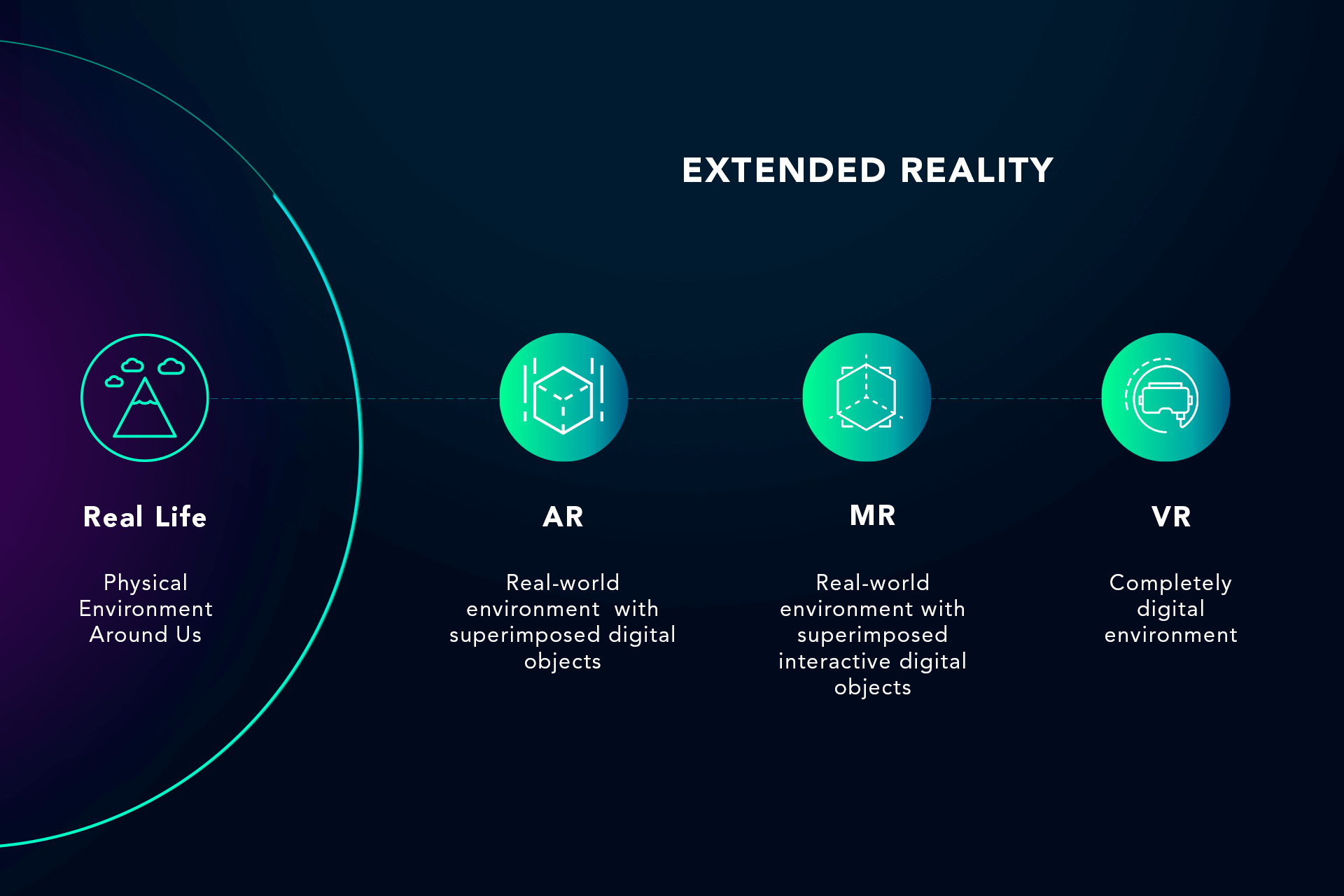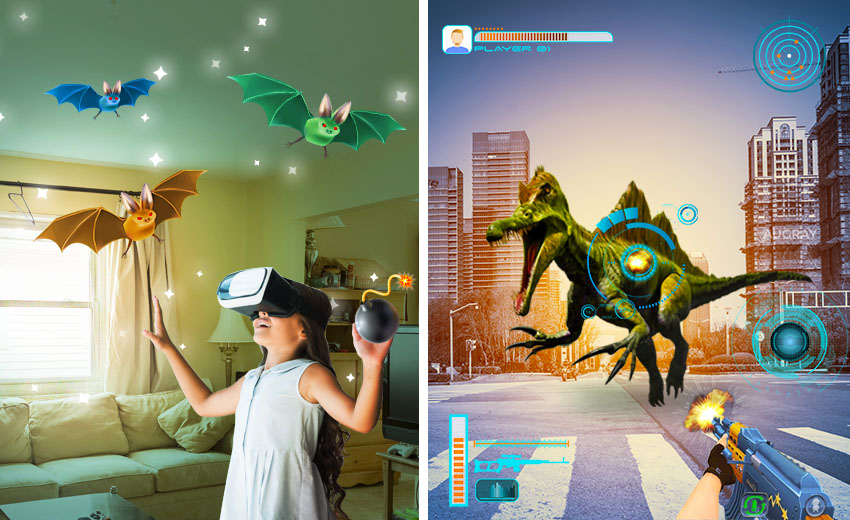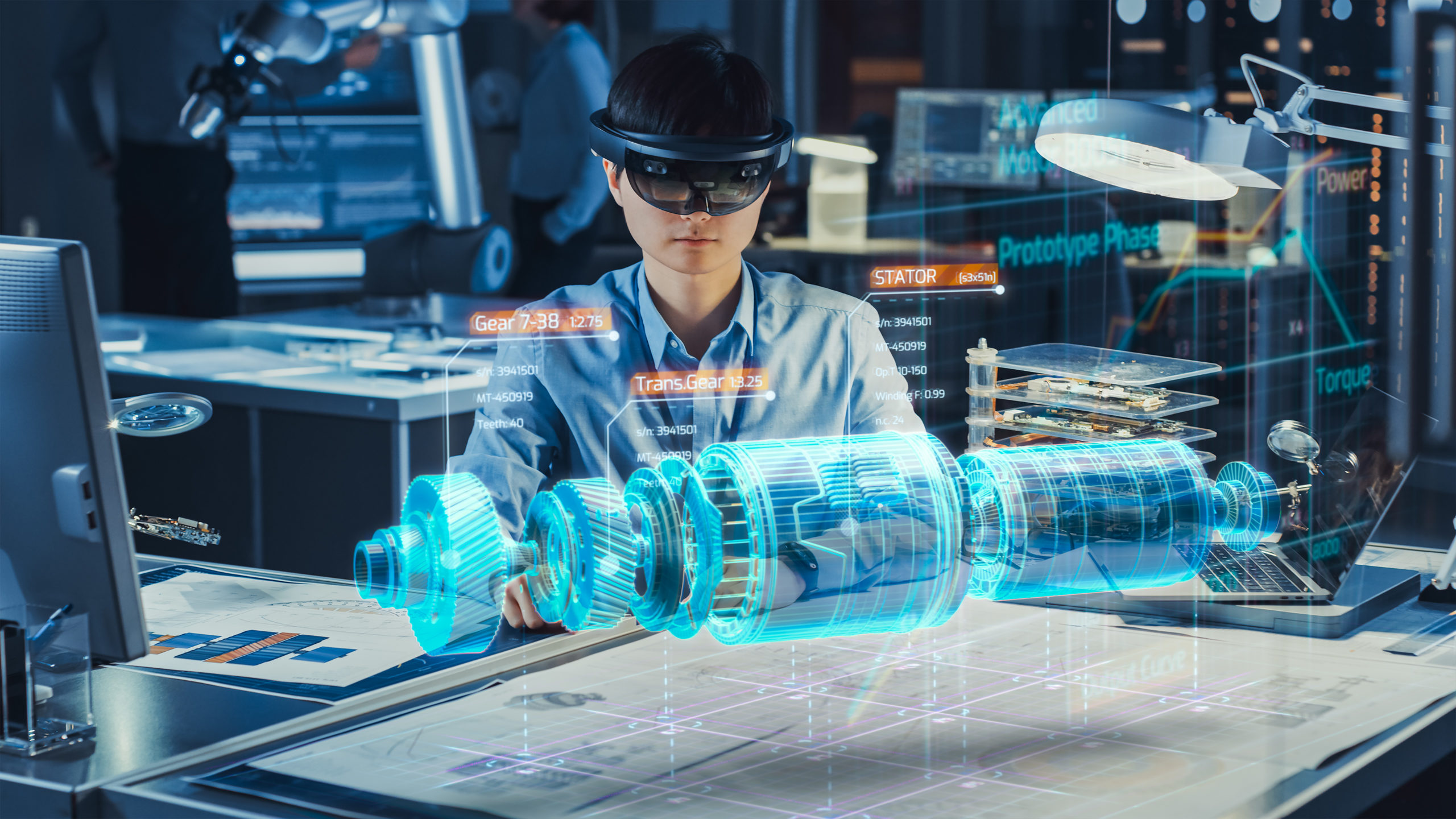The essence of all realities.
The idea of a digital world isn't new, as portrayed by thrillers like Tron or Avatar.
For years, filmmakers have tried to capture the essence of a digital world on the big screen. An extended reality, where your constants change, imagination thrives and wishes come true.
Extended reality is now no longer just the plot of a sci-fi movie, but a real feat of the tech world. Extended collaboration using augmented reality visualization software has taken brand experiences and consumer acquisition up a notch for diverse marketing firms.
What is extended reality?
Extended reality or XR is an umbrella term for augmented reality, virtual reality. mixed reality, and other up-and-coming “realities.” It’s a futuristic concept combining the forces of all emerging technologies representing human-computer interactions. Extended reality can be perceived through an XR headset and compatible software.
From gaming to retail to healthcare and beyond, the extended reality has revolutionized every industry consumers support. Whether you’re using a driving simulator or ringing up a “customer” on a virtual cash register system, you’re in extended reality.
Any extended reality interaction can be bettered with 5G technology, cloud computing, artificial intelligence (AI), and quick human reflexes.
Extended reality technology components
The extended reality spectrum ranges from one end where no digitization is involved to the other where we live and breathe in the metaverse. The entire virtuality continuum, as shown below, is the playing field of extended reality.
 Source: Softengi
Source: Softengi
This technology elevates our perception of reality through digital overlays like images, text, and computer-generated animation. Essentially, there are different components of extended reality technology that you can work with:
Augmented reality
Augmented reality is an interactive way to overlay 3D visuals or data in a user's real-world surroundings. Say you’re a first officer who is about to fly a plane for the first time, augmented reality can virtually simulate flight information over your windshield and help you check engines, fuel, gears, displays, and control buttons in detail before taking off. More inspection means less fear while flying an airplane, which ultimately leads to your success as a pilot.
AR is becoming a standard tool for customer acquisition and satisfaction. One of its many use cases, namely AR marketing, is one of the core-focused areas receiving more investments lately due to the virtual product samples it creates for consumers, leading to increased retention and sales.
Three major types of augmented reality applications are being used across different commercial and non-commercial domains right now:
- Object recognition in augmented reality identifies and predicts categories of real-world objects and overlays step-by-step audio or video instructions.
- Plane recognition is a technique to overlay virtual holograms on a plane surface like a wall or floor for real-time interaction via AR wearables.
- Scenario training is used to train employees virtually on complex systems like retail POS and study buttons, interfaces, and controls to improve expertise.
Pokemon Go, a prominent AR game, can also be called an XR game. However, the Windows Mixed Reality Portal cannot be considered an augmented reality platform since it creates mixed reality experiences for the users.
Virtual reality
Virtual reality is a digital replica of the natural world. Users can submerge themselves in a virtual environment through a dedicated VR headset which has AI sensors, LED screens, and input trackers. Virtual reality mainly focuses on building social connections in an artificially rendered reality to create full-scale immersions. For critical domains of mining or construction, it allows professionals to perform critical tasks with no risk of danger.
Key characteristics of virtual reality:
- Computer-generated, 3D-responsive technology.
- Virtual controllers that control body movements
- Head and position tracking to navigate freely in a virtual environment
- Head-referenced viewing to get a natural interface for navigation
- Spatial audio to enhance your listening experience
- Stereoscopic viewing to enhance concentration, sense of depth, and engagement
- Realistic interactions with virtual objects to evaluate their purpose
- Built-in haptic, auditory, and visual overlays to maintain the illusion
- Downloadable 3D assets to manipulate virtual surroundings
- Tethered VR softwares to for undisturbed flow of immersion
It's important to note that while a virtual reality experience like "the metaverse" is also an XR experience, an extended reality experience isn't necessarily defined as virtual reality.
Mixed reality
Mixed reality is a blend of physical and digital worlds where different elements of both worlds co-exist and communicate in real time. MR has been at the forefront of research and development for many industries as a newfound immersive technology. Microsoft Hololens and Magic Leap are two hybrid MR headsets that create stunning holographic projections of real-world objects in different physical scenarios that you can interact with.
As of now, a few agencies are investing their budgets in creating high-performance, blended experiences with MR tech to predict weather calamities or run screen-less video calls. Mixed reality experiences will mostly be a thing of the future, where you can be in two different physical environments at once, experiencing the best of both worlds.
Mixed reality is also known as augmented reality 2.0 or enhanced AR.
Did you know? In a market research report by Juniper Research, it is predicted that AR/VR applications will touch the 10 billion mark for installations by 2024, and the market will be valued at $43.8 billion!
Möchten Sie mehr über Erweiterte Realität (AR) Visualisierungssoftware erfahren? Erkunden Sie AR-Visualisierung Produkte.
Extended reality examples
The idea of extended reality was born when Sir Charles Wheatstone, an English scientist, introduces "stereoscopic vision" or 3D vision. His newfound vision of a virtual future set humankind on an endless journey of technological inventions.
In 2014, Google made news by launching "Google Cardboard" and "Google Glass AR" which provided a sense of augmented reality at an affordable cost. This was again a baby step taken in the direction of extended reality.
As more and more use cases sprang up, IT as well as consumer brands started using some form of XR in their daily operations. The extended reality, when combined with other data-driven technologies keeps virtual backups of product information in the real world and creates brand recall. A sudden popup of useful information or multimedia settings that a user can control through skin contact as they saunter in a garden sets an excellent example of immersive customer experience with extended reality. Here are other examples:
- Gaming: Both augmented and virtual reality technologies create immersive games. For example, Knightfall AR, Pokemon Go, Half-life, Alyx, and Moss are all examples of immersive augmented reality games you can explore. On the other hand, VR gaming completely immerses a gamer into pseudo-surroundings to interact with other people behind a screen via digital avatars.
 Source: Augray
Source: Augray
-
Design: Extended reality demonstrates high-end product designs via creative 3D visuals. Companies like McLaren or BMW have integrated VR softwares with traditional design applications like AutoCAD to create real-life simulations of a car model.
Through extended reality, they can place a 3D car model in a physical space and inspect loose systems, missing pieces, and interiors in detail. It gives them a newfound idea of how the car will look post-manufacture.

Source: Medium
-
Real estate: XR is also used to conduct virtual showings of real estate listings, especially if it’s inconvenient for people and real estate agents to meet. It can run virtual open houses for customers so they can get an in-depth look into the property before buying it.
Tip: Matterport provides real estate agents with 360° VR tours of properties, including traversing hallways, measuring floor length, and studying interior decor.
- Education: Extended reality is an experiential way to teach students concepts faster. In med schools, it can create cloud-based virtual models for students to understand human anatomy better. During interviews, XR simulation can help candidates practice their speaking skills in a virtual environment. It also breaks down difficult concepts through the visual representation of objects.

Source: Forbes
-
Corporate training: As corporate organizations set a new workplace culture in motion, XR solutions are being extensively used to scale cross-functional employee training. Executives can be trained in an immersive and safe environment, which increases concentration and productivity.

Source: Robotic Business Review
Did you know? The first ever XR-Land metaverse, Imversed intends to combine AR/VR technology with geo-attached lands to create a fully immersive reality that merges the virtual worlds with physical worlds. Their visual display preview will be launched in October 2022.
-
Defense: XR headsets can help soldiers navigate different terrains during reconnaissance missions. By superimposing virtual data over the real-world, military personnel can locate military equipment and friendly troops to build opposition strategies. Extended reality can even teleport soldiers to a combat zone for skills training.
Source: YouTube
- Travel and tourism: Extended reality can help create 360° audiovisuals of any place in the world, which can ignite your wanderlust. Many travel and tourism companies run their promotional travel campaigns via XR at a fraction of the cost of traditional drives.
Example: The Jordanian government has launched Petra Xplore, which uses VR to teleport visitors to UNESCO world heritage sites. As users virtually explore the country of Jordan, a virtual narrative helps them understand the history and significance of the place.
-
Consulting: Companies like Accenture are using different applications of extended reality to expand their consulting services across the globe. Through high-level XR wearables, employees and clients can communicate in a virtual environment, sign deal agreements, and process monetary transactions smoothly.
Source: YouTube
Here are some applications of extended reality that Accenture has been using to scale its operations successfully:
- Artificial intelligence: The XR wearables have built-in AI sensors, LEDs, and 3D lenses and are tethered to external software to provide high-resolution visuals.
- Blockchain: Blockchain technology acts as a virtual passport that secures identity and financial transactions within the metaverse for successful closures.
- Cloud computing and 5G are used for the fast rendering of data, images, documents, and other collaterals across different geographic locations.
- Security technology masks essential details like bank account information, card numbers, or accounting software login credentials to prevent virtual data thefts.
Soon, Meta will rule the technological space with Project Cambria, a hybrid "all in one" (AIO) headset encompassing AR and VR components into one standalone device.
Benefits of extended reality
Considering the wide range of proposed applications of extended reality, it might be too soon to measure its range of benefits. Based on the experiences created by extended reality subsidiaries for different companies, we’ve put together some benefits it offers.
- Increased user engagement: The interactive nature of XR solutions brings elements to life, thereby creating a highly personalized user experience. With built-in gamification, users can combine monotonous activities like working on a machine with captivating visuals and audio to infuse fun into everything they learn.
- Optimized ROI: Ensuring every marketing initiative generates maximum return on investment (ROI) is the objective of every company. This objective has facilitated the widespread use of XR solutions for marketing and advertising. Immediate brand recall in the customer's physical surroundings can invoke a quick call to action, thereby optimizing ROI.
- Increased knowledge retention: With extended reality, users pay more attention to their surroundings, leading to improved knowledge retention. XR can bring 2D objects to life, provide supplemental content and make you interact with them in real-time to improve your cognitive skills.
- Increased customer loyalty: Customers always chase experiences that are unique and informative. The extended reality aims to deliver excellent customer experiences and help brands flourish their eCommerce growth strategy with all its variations.
- Secure data transfer: XR solutions are powered with end-to-end encryption to prevent data theft or leakage. Be it credit card numbers, crypto cash, NFT, or any other monetary transfer, users can rest assured of the tight security standards of extended reality applications.
- Lower operational costs: The probationary training of employees often require them to spend extra hours after the office which makes them grow unwillingly. Not only does XR help in eliminating travel and time costs, but it also optimizes employee productivity and spirit. Trainers may or may not be a part of the XR experience, as employees can teach themselves many things quickly.
- High serviceability: As 5G technology becomes mainstream, extended reality will be used in conjunction with it to run diverse operations across the globe. Creating an exit poll, collecting election votes, or organizing a G20 summit will be pursued with the help of XR in the future.
- Improved bottom line: Different commercial case studies have proven that consumers who use some form of extended reality to interact with a brand, end up purchasing the product more than those who don’t. Extended reality enables consumers to sample a broad range of products, across brands of different repute.
Challenges of extended reality
As extended reality is a novel technology, a lot of effort goes into creating an XR experience and there have definitely been a few setbacks along the way.
- Cyber offenses: Extended reality needs clear laws on what is acceptable or unacceptable in the virtual space. A lack of a legal system can warrant an increased number of cyber crimes in the future.
- Moral concerns: In an XR space, people can act out whatever they want without facing any consequences. Sometimes, people can cross legal, moral, ethical, or religious boundaries in the virtual world, which can hurt feelings – or worse – in the real world.
- Digital fatigue: Spending a lot of time in extended reality may result in cyber addiction, motion sickness, and nausea due to the brain being confused between real and virtual elements.
- Low operational efficiency: As XR experiences can be created using cloud technology or 5G services, it currently has a low active rate across countries.
- Expensive: AR, VR, or XR headsets are costly, with a limited field of view (FoV) and a high and prolonged learning curve.
- Privacy: Extended reality experiences can sometimes result in a breach of personal information, leading to data theft, phishing attacks, and unethical hacking. Eye-tracking can enable companies to collect personal data on your unconscious reflexes to virtual clues.
Extended reality vs. mixed reality
Extended reality and mixed reality are two related terms. People often get confused about which one of these technologies are used to create blended digital experiences. The answer is mixed reality.
-png.png)
Extended reality is an umbrella term that encapsulates all different types of emerging tech for the sake of consumer benefits. Be it augmented reality, mixed reality, or virtual reality, extended reality combines all benefits with narrow AI to create photorealistic experiences.
Mixed reality offers a user the best of both realities: real and virtual. It can help you visualize an entirely different virtual scenario from the comfort of your home. Imagine saying hello to a dolphin or taking soccer tips from Aaron Ramsey without having to travel for either. Sounds unreal, but MR makes it possible.
Common properties of extended reality devices
XR glasses or headsets are equipped with infra-red LED screens and stereoscopic lenses, which give the illusion of being in a 3D environment to the user. The constant translation of programming software into virtual scene refreshes by the device provides a surplus of virtual information to the user, which elevates their sense of interpretation and perception. Here are some common properties of XR devices:
-
6DoF: 6DoF or six degrees of freedom allows the user to move freely within a virtual environment. They can move right, left, back and forth, and rotate their head to interact with objects and people.
- Low latency: An XR system or network provides low latency, which means lags between different virtual scenes. Quick scene refreshes and minimal delay in time create an entirely immersive virtual experience.
- Full Immersion or full VR can teleport you to a high-fidelity environment that resembles our real world, with added sound, texture, and illumination. The latest XR wearables have built-in spatial audio and virtual lights that make users feel at home in a virtual environment.
- Frame rate and shutter speed need to be precise. An ideal VR experience must have an optimal frame rate of 90 frames per second (FPS) and a shutter speed of 1/125 to 1/60 seconds. However, the shutter speed must be quicker to prevent camera shakes when it gets darker.
- Optimal resolution of 8K per eye with a 90 Hz refresh rate. While 4K is currently a de-facto HD display, it is not enough to create extended reality experiences.
- Field of View (FOV) is a metric of how much area an XR headset can capture. The standard human FOV ranges between 200-22O degrees. In XR, a higher FOV contributes to the power of immersion.
- Anomaly detection automates threat protection across hybrid environments to prevent incorrect usage of data.
- Artificial intelligence and machine learning techniques like object detection and image recognition develop baselines for system vision and behavior.
- Extended detection and response (XDR) tools automate the discovery and reconciliation of security issues across hybrid experiences. These tools can perform detection and response related to networks, endpoints, and cloud services.
Call it magic, call it XR
Extended reality is not just another technological innovation: it's the wave of the future. In the coming years, routine activities like going to a movie, playing badminton, or fighting over the last slice of pizza will all be virtual events. Transcending into XR will power us with the utmost resilience to live and thrive in a digital economy.
Go back to the basics! Drive actionable insights from your consumer data to shape new brand experiences across mobile and web platforms with the best AR software development kit.

Shreya Mattoo
Shreya Mattoo is a Content Marketing Specialist at G2. She completed her Bachelor's in Computer Applications and is now pursuing Master's in Strategy and Leadership from Deakin University. She also holds an Advance Diploma in Business Analytics from NSDC. Her expertise lies in developing content around Augmented Reality, Virtual Reality, Artificial intelligence, Machine Learning, Peer Review Code, and Development Software. She wants to spread awareness for self-assist technologies in the tech community. When not working, she is either jamming out to rock music, reading crime fiction, or channeling her inner chef in the kitchen.

